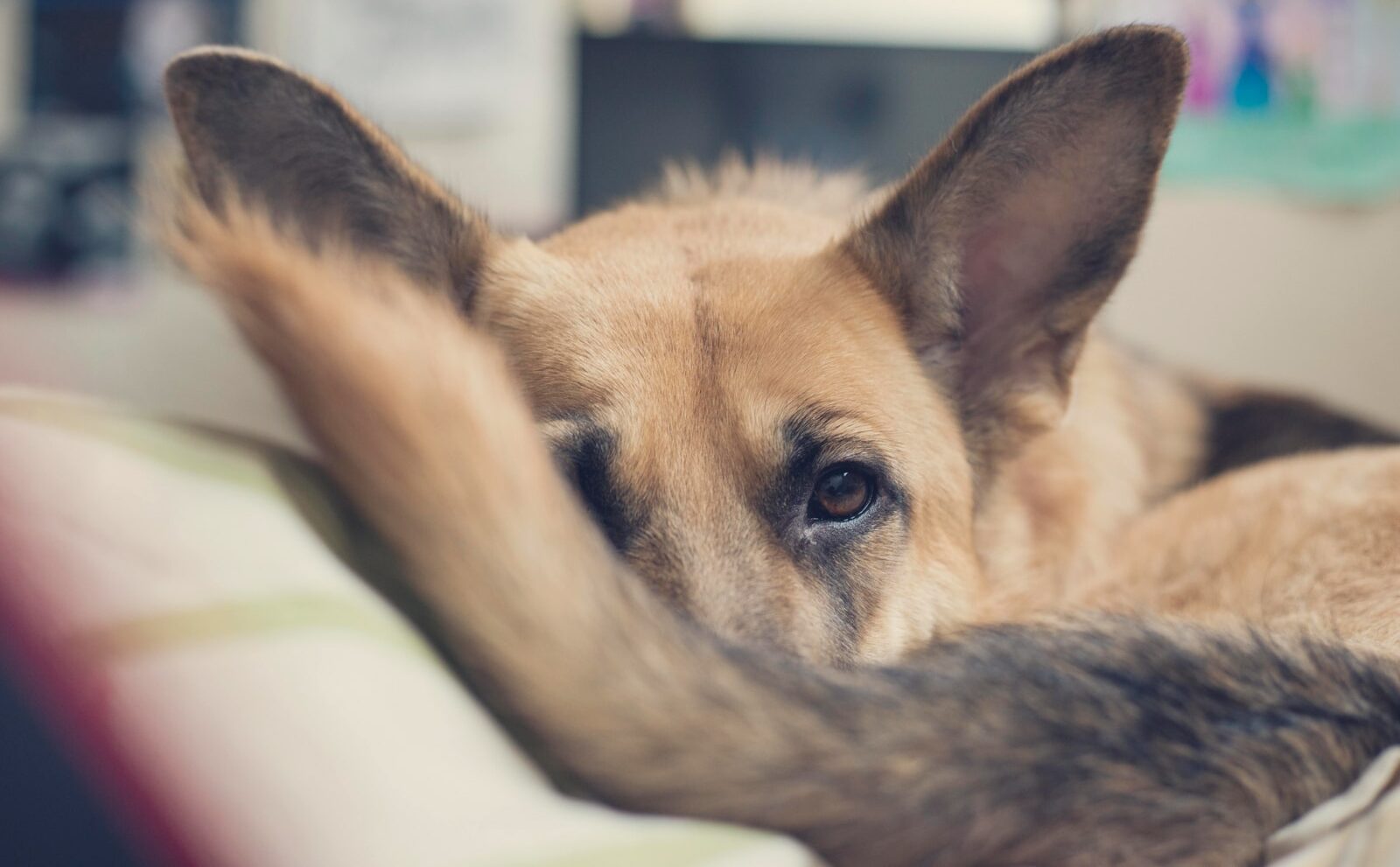
Key points
- A dog may begin chasing, licking, and chewing its tail because it is bored, stressed, or anxious, because it’s suffering from a parasite infestation, issues with its anal glands, tailbone trauma, and other conditions.
- If your pet’s tail biting behavior has become excessive, it’s best to consult a vet to get an accurate diagnosis.
- You might need to use topical or oral medicine to address the issue, change your pet’s food to address its allergies, adjust its behavior, and provide the pet with plenty of mental and physical stimulation to prevent it from biting its tail in the future.
As a dog owner, you can probably name countless hilarious things that your pet does. And one of those probably has to do with the dog chasing its tail. However, sometimes it might seem like it’s no longer just a fun trick or game your pet is playing. If you notice that your dog is chasing or biting its tail excessively, it’s essential to carefully observe your dog to determine the reason for this behavior. Once you know what’s causing the issue, you will be able to choose the right treatment that will prevent your pet from biting its tail.
Table of Contents
Why Do Dogs Chew Their Tails?
 Unfortunately, determining why your pet keeps biting its tail is not always easy. You will likely need to use trial and error to find out the exact reason for the unwanted behavior. In many situations, you may even need to consult a vet, especially if your dog is chewing its tail raw or causing other significant damage to its body. Below, you will find some reasons why a dog might chew its tail:
Unfortunately, determining why your pet keeps biting its tail is not always easy. You will likely need to use trial and error to find out the exact reason for the unwanted behavior. In many situations, you may even need to consult a vet, especially if your dog is chewing its tail raw or causing other significant damage to its body. Below, you will find some reasons why a dog might chew its tail:
Allergic Reaction
Many dog owners don’t know that their dogs can suffer from allergies just like humans. Pets can be susceptible to a wide range of allergens starting from different foods to environmental allergens such as pollen, dust, and even household cleaning products. Canine allergies are often caused by parasites such as ticks, mites, and fleas. If a dog develops dermatitis due to allergies, its skin will become red, itchy, and inflamed. As a result, the pet might bite and chew its tail and the skin around it to relieve unpleasant sensations.
Anxiety
Dogs often suffer from stress and anxiety. While humans can bite their nails or scratch their skin in an attempt to relieve stress, dogs can also engage in destructive and repetitive behavior to calm themselves. One type of such behavior is tail biting. Keep in mind that dogs generally tend to direct these destructive behaviors out into the environment. However, if you often create your pet, it may begin biting its tail because it has nothing else to do. You can alleviate these stress-related behaviors by spending more time with your pet, giving it more opportunities to exercise, or giving it mentally stimulating toys to play with.
Parasites
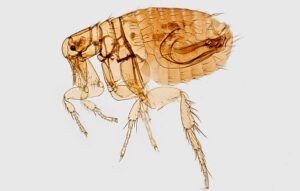 As mentioned above, many dogs are negatively affected by flea and tick bites. If a parasite has bitten your dog, it may begin licking, scratching, and chewing at the spot where it was bitten to relieve pain and discomfort. Some dogs can also be allergic to flea and tick saliva, which may cause them to scratch and bite their tail and back. Plus, if your dog is infected with a tapeworm, it may experience severe discomfort around its anal area, which may cause the pet to bite and scratch the base of its tail and its anus. Fortunately, in most cases, pet owners can alleviate their dogs’ symptoms by giving them oral medication or medicated baths that will help soothe itching and pain and prevent the pet from getting infected with parasites.
As mentioned above, many dogs are negatively affected by flea and tick bites. If a parasite has bitten your dog, it may begin licking, scratching, and chewing at the spot where it was bitten to relieve pain and discomfort. Some dogs can also be allergic to flea and tick saliva, which may cause them to scratch and bite their tail and back. Plus, if your dog is infected with a tapeworm, it may experience severe discomfort around its anal area, which may cause the pet to bite and scratch the base of its tail and its anus. Fortunately, in most cases, pet owners can alleviate their dogs’ symptoms by giving them oral medication or medicated baths that will help soothe itching and pain and prevent the pet from getting infected with parasites.
Hot Spots
If your dog frequently chews, scratches, or bites the same area on its body, the pet may develop a hotspot, an open wound on the surface of the skin. Hot spots are especially common in moist and warm areas of the pet’s body. Warm and moist environments are conducive to bacterial growth, so your pet can develop a secondary bacterial infection in the hot spot area. You can identify hot spots on your dog’s skin by matted fur, bald spots, scabs, inflamed skin, and blood or pus coming from the skin.
Issues With Anal Glands
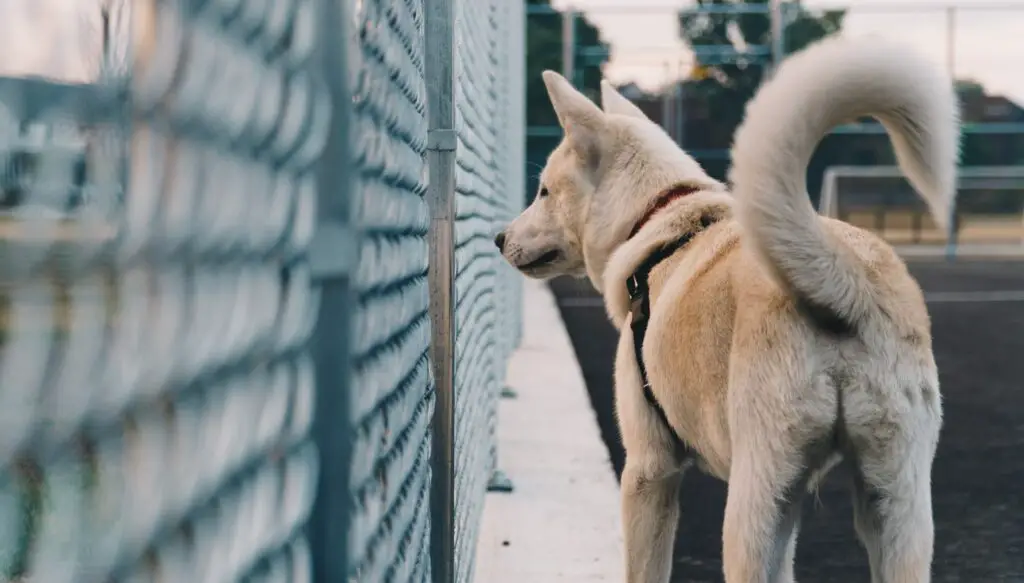
Anal glands are an extremely important part of a dog’s body. When dogs meet other dogs, they begin secreting fluid from their anal glands. Other dogs will detect this fluid when they smell the dog’s rear end. Dogs can exchange a lot of information via the fluid excreted from their anal glands.
One reason why your dog may be biting or chewing its tail is that its anal glands have been impacted. Other symptoms of canine anal gland disorders can include constipation, unpleasant smell coming from the dog’s anus, and scooting, which occurs when your pet sits down on the floor and starts dragging its rear end on the ground. If there are severe issues with your dog’s anal glands, you may even notice blood or pus in its feces.
Injuries
If your dog has injured its rear end, it may begin biting it’s tail to draw it’s owners attention to the problem. Some of these issues can be relatively easy to spot, while others may require a thorough examination by a vet to be diagnosed. For instance, if your dog has fractured its tailbone, you will not be able to detect the issue using a visual inspection, however, the pet will still be suffering from severe pain.
Boredom
Just like humans, dogs can easily get bored, especially if they are left alone for a long time or if the owner doesn’t pay enough attention to the pet and provide it with enough exercise. Humans can play with their hair or shake their feet when they’re bored, while dogs can begin chasing and biting their tails and rear ends to deal with the boredom. Sometimes, this can lead to the pet developing serious skin conditions, as the bite site can become inflamed and infected. If your dog’s tail biting is triggered by boredom or excessive excitement, you need to break the cycle by giving your pet engaging toys when you leave the house or calming it down as soon as it becomes too excited.

Hormonal Issues
Sometimes, a dog biting its tail may be a symptom of hormonal imbalance. For instance, if the dog’s thyroid gland is not producing enough hormones or if there is an excess amount of cortisol in the dog’s body, it can become susceptible to skin infections. As a result, the pet will lick, scratch, and bite this infected spot, leading to further skin damage and even loss of fur.
Bad Hygiene
Sometimes, a dog can begin scratching and biting at its tail and anal area if it’s suffering from conditions that were brought about by bad hygiene. If your pet’s anus is frequently dirty, the dog may develop fecal mats, which will cause its skin to become inflamed and infected. A dog’s dirty anus can even attract flies, which may result in a maggot infestation, so keeping an eye on the pet’s hygiene is crucial.
Looking For Attention
If you or family members frequently laugh and praise your dog when it chases its tail, it can lead to the pet displaying this behavior more and more regularly. Essentially, whenever your pet wants to get attention from you, it will begin chasing its tail. This may be counterintuitive, but admonishing your dog for chasing its tail is not a good way to try and stop the behavior. Instead, you should simply ignore the pet when it starts chasing or biting its tail and praise the dog when it stays calm.
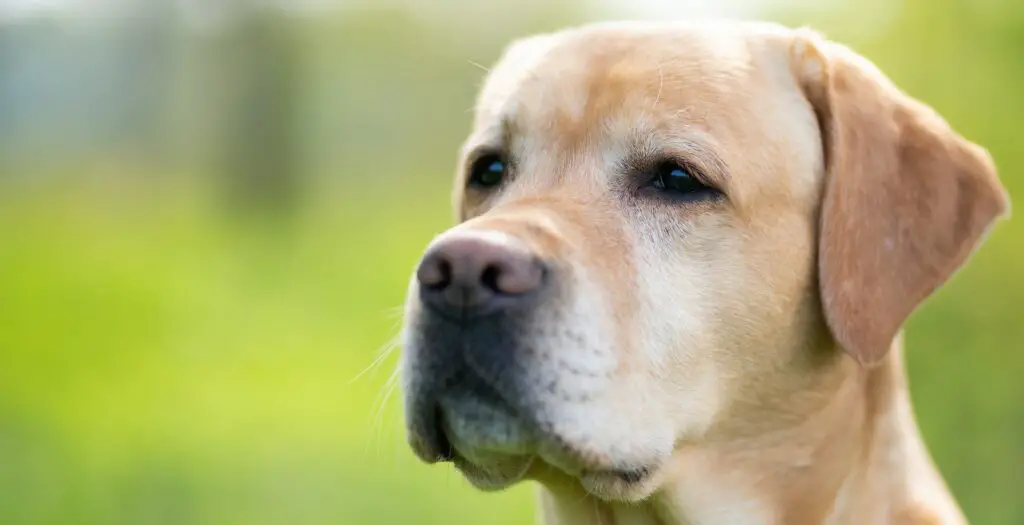
Things You Can Do To Stop Your Dog From Biting Its Tail
There are a few things you can try to prevent your pet from biting its tail, depending on the cause of the issue. Keep in mind that you may need to consult a vet to determine the exact reason why your dog is chasing and chewing its tail and select the proper treatment for the problem.
Switch To A Different Dog Food
If you suspect that a food allergy causes your dog’s behavior, you need to consult your vet to determine which allergen is causing the reaction. Your vet can then help you choose a new dog food that does not contain that allergen. Once you switch your dog to a new food, the issue should go away by itself very quickly.
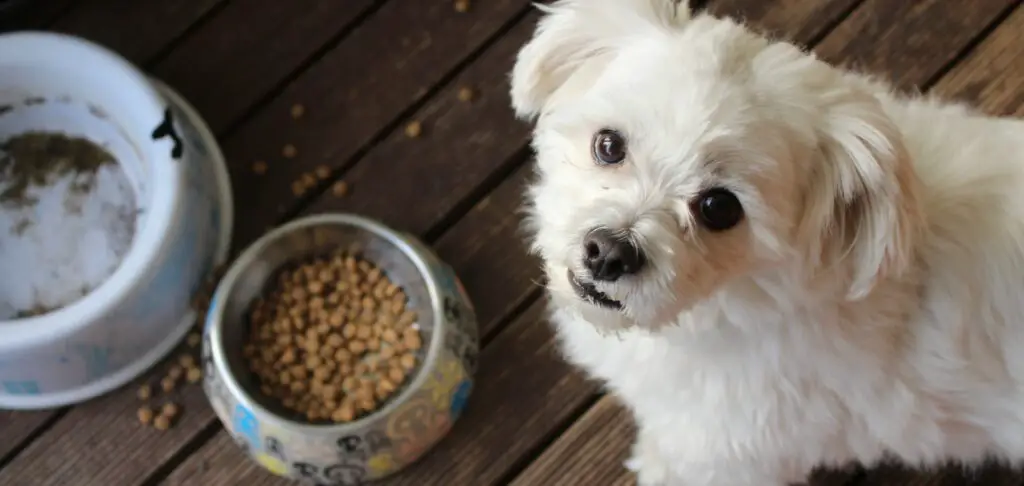
Get Rid Of Parasites
If your dog’s tail biting behavior occurs due to a parasite infestation, it’s essential to treat the pet with medication. Your vet will be able to prescribe appropriate treatment after examining the animal. Remember that if your dog is suffering from a flea infestation, you will also need to wash the pet’s toys and bedding and thoroughly clean your home to get rid of all the fleas and their eggs and avoid reinfestation. You will also need to treat all your other pets against fleas and other parasites. Finally, remember to deworm your dog once every 6 months.
Use Medicine To Treat Skin Problems
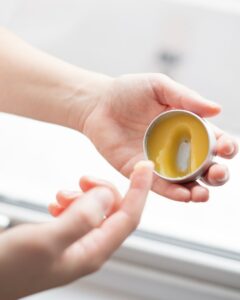
Depending on the issue causing your dog’s tail chewing behavior, your vet may prescribe different drugs. For instance, if your pet is biting its tail because the skin on that part of the body is dry and itchy, you will need to apply a topical ointment or give the dog oral medicine to help combat its skin condition. If your dog has hot spots on its body, you may need to combine an anti-itch cream and an antibiotic to ensure that the area doesn’t get infected and can heal properly. Finally, if your dog is suffering from an allergic rash, you can use steroids or anti-itch creams to help the pet feel better and prevent it from biting and scratching at its tail.
Changing Your Dog’s Behavior
In addition to using medicine and new food to minimize your dog’s tail biting, it’s essential to address the behavioral side of the problem. For instance, you can use bitter-tasting sprays on the dog’s tail to discourage it from biting or gnawing at the tail. If this doesn’t help, you can put a special collar on your dog’s neck to prevent it from chewing on the tail. Finally, you can correct your dog’s behavior by telling it “No” or “Leave it” when you see the pet starting to chew on its tail. You can also use positive reinforcement by praising your dog and giving it treats when it stops the unwanted behavior after hearing your command.
Alleviating Stress, Anxiety, and Boredom
 If you suspect that your pet may be chewing its tail because it’s bored, under-exercised, or lacks attention, you can remedy the situation by spending more time with your dog, taking it on long walks, or exercising it more. You should also provide the pet with plenty of toys, bones, and other chewing material to direct its destructive behaviors properly. If nothing helps, you may need to consult an animal behavioralist.
If you suspect that your pet may be chewing its tail because it’s bored, under-exercised, or lacks attention, you can remedy the situation by spending more time with your dog, taking it on long walks, or exercising it more. You should also provide the pet with plenty of toys, bones, and other chewing material to direct its destructive behaviors properly. If nothing helps, you may need to consult an animal behavioralist.
Ensuring Proper Hygiene
Generally, dogs don’t require frequent bathing. However, if your pet is frequently dirty or has feces stuck to its fur around the anus, you need to clean the pet often to prevent severe health problems from developing.
Let Your Dog’s Injuries Heal
If an x-ray has shown that your dog’s tailbone is fractured, the pet may need to get splinters or other medical treatment. Plus, it will most likely need to wear an Elizabethan collar until the injury heals completely.
FAQ
How do I stop my dog from biting his tail?
Your choice of treatment should depend on the season for the dog’s tail biting behavior. For instance, if the pet is suffering from parasites like ticks, mites, or tapeworms, you will need to administer medicine to eliminate the issue. On the other hand, if the pet is biting its tail out of boredom, you will need to give it more toys and exercise.
Why does my dog keep licking and biting his tail?
Dogs may lick and bite their tails for many reasons, including anal gland issues, tailbone trauma, parasite infestations, boredom, stress, poor hygiene, etc.
Is it bad if my dog bites her tail?
If your dog bites your tail only occasionally and the behavior doesn’t cause any issues, it does not need to be treated. However, if this behavior occurs frequently or causes the pet to develop wounds on the tail, it needs to be addressed ASAP.
How do you treat a dog’s raw tail?
Generally, you will need to apply a topical antibiotic to the dog’s tail and bandage it up until it can fully heal. You can also put an Elizabethan collar on the pet until its tail fully heals. However, it’s best to consult your vet regarding appropriate treatment.




